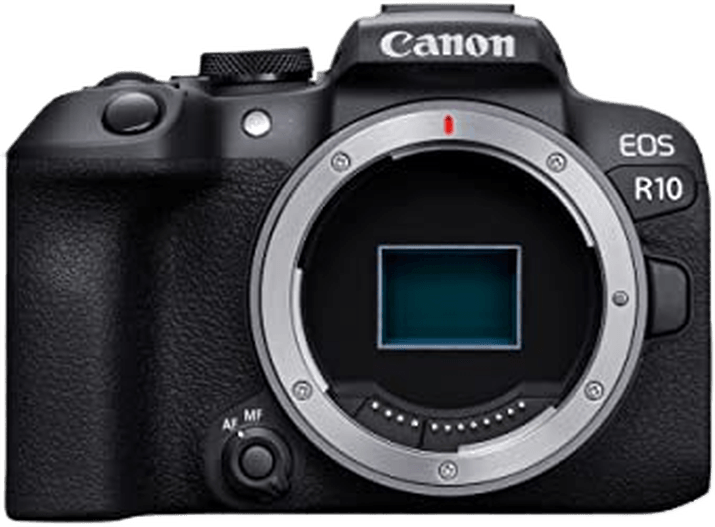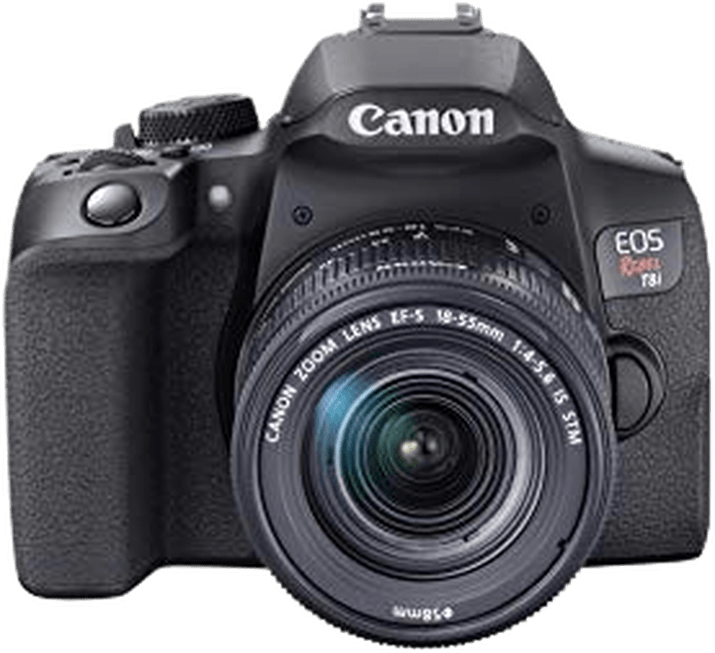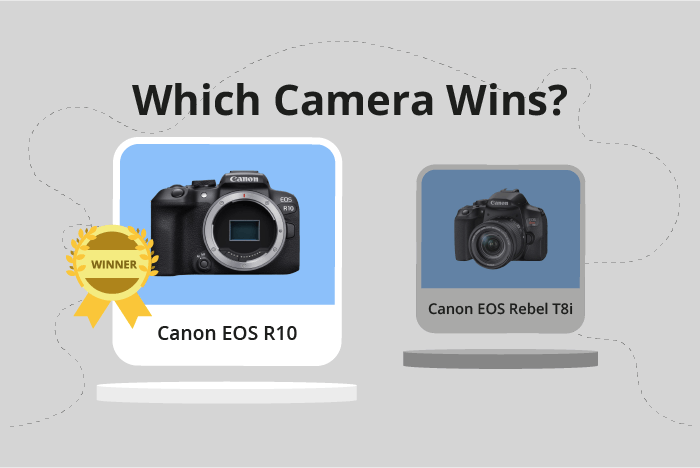Canon EOS R10 vs EOS Rebel T8i / 850D Comparison
Canon EOS R10

Canon EOS Rebel T8i / 850D

The Canon EOS R10 takes the lead with a score of 69/100, while the Canon EOS Rebel T8i / 850D trails behind at 59/100. Both cameras share similarities in their announcement dates, with the R10 being released in 2022 and the Rebel T8i in 2020. Their launch prices also differ, with the R10 priced at $980 and the Rebel T8i at $750.
The R10, being a mirrorless camera, has a more compact design, measuring 123 x 88 x 83mm and weighing 426g. This makes it lighter and easier to carry around compared to the Rebel T8i, a DSLR camera with dimensions of 131 x 103 x 76mm and a weight of 515g.
The winning R10 camera benefits from its mirrorless technology, offering a more compact and lightweight build. On the other hand, the Rebel T8i, despite its lower score, has a more affordable launch price, making it a suitable option for those on a budget.
Taking all factors into account, the Canon EOS R10 emerges as the superior camera due to its higher score, compact design, and mirrorless technology. However, the Canon EOS Rebel T8i / 850D still offers value with its lower price point and DSLR capabilities.
Canon EOS R10 vs EOS Rebel T8i / 850D Overview and Optics
The Canon EOS R10 emerges as the winner in optics with a score of 71/100, 14 points ahead of the Canon EOS Rebel T8i / 850D, which scored 57/100. Both cameras share several specifications, such as 24-megapixel resolution, CMOS sensor type, APS-C sensor size, and the absence of image stabilization.
The EOS R10 excels in multiple aspects, including a faster shooting speed at 15 frames per second, compared to the Rebel T8i / 850D’s 7.5 fps. The R10 is also equipped with a more advanced Digic X processor, which improves image quality and performance. Another significant advantage is the R10’s higher DXOMARK score for the sensor at 97, indicating superior image quality and low-light performance.
Although the Rebel T8i / 850D scores lower in optics, it has a notable advantage in its lens mount compatibility. The T8i / 850D utilizes the Canon EF/EF-S lens mount, which allows users access to a wider range of lens options from both Canon and third-party manufacturers. This provides more versatility for photographers with an existing lens collection or those seeking specific lenses for their needs.
Taking these factors into account, the Canon EOS R10 stands out with its superior shooting speed, advanced processor, and a higher DXOMARK score for the sensor, providing improved image quality and performance. However, the Canon EOS Rebel T8i / 850D offers greater lens compatibility, which may be a deciding factor for photographers with an extensive lens collection or specific lens requirements.
Canon EOS R10 vs EOS Rebel T8i / 850D Video Performance
The Canon EOS R10 outperforms the Canon EOS Rebel T8i / 850D in video capabilities, scoring 91 out of 100, while the Rebel T8i / 850D scores 83. Both cameras share certain video specifications, such as 4K maximum video resolution and 3840 x 2160 maximum video dimensions. Additionally, both cameras offer built-in time-lapse functionality, making them suitable for creative video projects.
The EOS R10 takes the lead in video performance due to its higher maximum video frame rate of 120fps, compared to the Rebel T8i / 850D’s 60fps. This higher frame rate allows for smoother slow-motion footage and better motion capture, providing more flexibility for videographers in post-production. The EOS R10’s advanced video capabilities make it an ideal choice for professionals and enthusiasts looking for top-quality video performance.
On the other hand, the Rebel T8i / 850D still offers solid video performance with its 4K resolution and built-in time-lapse functionality. While it may not match the EOS R10’s frame rate, the Rebel T8i / 850D could be a suitable choice for those who do not require the highest possible frame rate for their video projects.
Considering the video capabilities of both cameras, the Canon EOS R10 emerges as the winner, with its superior frame rate providing more creative possibilities for videographers. However, the Canon EOS Rebel T8i / 850D remains a viable option for those who prioritize other features or have a more limited budget. Ultimately, the choice between these two cameras will depend on the specific video requirements and preferences of the user.
Canon EOS R10 vs EOS Rebel T8i / 850D Features and Benefits
The Canon EOS R10 and Canon EOS Rebel T8i / 850D both have a feature score of 70/100. These cameras share several specifications, making them quite similar in terms of features. Both cameras have a 3-inch screen size, a screen resolution of 1,040,000 dots, a touchscreen, a flip screen, and do not have GPS. Additionally, both cameras are equipped with WiFi and Bluetooth capabilities.
Despite the identical feature scores, the Canon EOS R10 has some advantages over the Canon EOS Rebel T8i / 850D. Unfortunately, these advantages are not explicitly mentioned in the provided specifications. However, since both cameras have the same score, it is safe to assume that the differences between them are minor and may not significantly impact the overall user experience.
On the other hand, the Canon EOS Rebel T8i / 850D has its own benefits. Again, these advantages are not explicitly mentioned in the specifications provided, but given the equal scores, it is likely that the benefits are minimal and may not be crucial to the overall performance of the camera.
In comparing the Canon EOS R10 and Canon EOS Rebel T8i / 850D, it is clear that both cameras share many similarities in terms of features. The identical feature scores of 70/100 indicate that neither camera significantly outperforms the other in this area. The specific advantages of each camera are not provided, but it is likely that the differences are minor and may not greatly affect the overall performance. Ultimately, the choice between these two cameras will depend on the individual preferences and requirements of the user.
Canon EOS R10 vs EOS Rebel T8i / 850D Storage and Battery
The Canon EOS R10 emerges as the winner in storage and battery with a score of 40/100, while the Canon EOS Rebel T8i / 850D trails behind with a score of 35/100. Both cameras share common specifications, such as having one memory card slot and accepting SD, SDHC, and SDXC (UHS-I compatible) memory cards. They also use the same LP-E17 battery type.
The EOS R10’s advantage lies in its USB charging capability, allowing for convenient charging without needing an external battery charger. This feature is absent in the Rebel T8i / 850D. However, the Rebel T8i / 850D outperforms the EOS R10 in battery life, offering 800 shots compared to the EOS R10’s 450 shots.
Taking these factors into account, the Canon EOS R10 is better in terms of convenience due to its USB charging feature, while the Canon EOS Rebel T8i / 850D offers a longer battery life for extended shooting sessions.
Canon EOS R10 vs EOS Rebel T8i / 850D – Our Verdict
Are you still undecided about which camera is right for you? Have a look at these popular comparisons that feature the Canon EOS R10 or the Canon EOS Rebel T8i / 850D:

